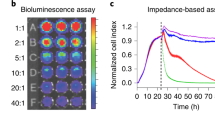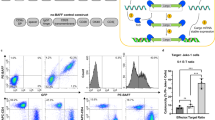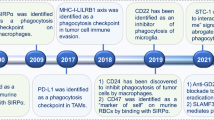Abstract
The human transferrin receptor (hTfR) is a target for cancer immunotherapy due to its overexpression on the surface of cancer cells. We previously developed an antibody-avidin fusion protein that targets hTfR (anti-hTfR IgG3-Av) and exhibits intrinsic cytotoxicity against certain malignant cells. Gambogic acid (GA), a drug that also binds hTfR, induces cytotoxicity in several malignant cell lines. We now report that anti-hTfR IgG3-Av and GA induce cytotoxicity in a new broader panel of hematopoietic malignant cell lines. Our results show that the effect of anti-hTfR IgG3-Av is iron-dependent whereas that of GA is iron-independent in all cells tested. In addition, we observed that GA exerts a TfR-independent cytotoxicity. We also found that GA increases the generation of reactive oxygen species that may play a role in the cytotoxicity induced by this drug. Additive cytotoxicity was observed by simultaneous combination treatment with these drugs and synergy by using anti-hTfR IgG3-Av as a chemosensitizing agent. In addition, we found a concentration of GA that is toxic to malignant hematopoietic cells but not to human hematopoietic progenitor cells. Our results suggest that these two compounds may be effective, alone or in combination, for the treatment of human hematopoietic malignancies.
This is a preview of subscription content, access via your institution
Access options
Subscribe to this journal
Receive 12 print issues and online access
$259.00 per year
only $21.58 per issue
Buy this article
- Purchase on Springer Link
- Instant access to full article PDF
Prices may be subject to local taxes which are calculated during checkout








Similar content being viewed by others
References
Andrews NC, Schmidt PJ . Iron homeostasis. Annu Rev Physiol 2007; 69: 69–85.
Daniels TR, Delgado T, Rodriguez JA, Helguera G, Penichet ML . The transferrin receptor part I: Biology and targeting with cytotoxic antibodies for the treatment of cancer. Clin Immunol 2006; 121: 144–158.
Kawabata H, Yang R, Hirama T, Vuong PT, Kawano S, Gombart AF et al. Molecular cloning of transferrin receptor 2. A new member of the transferrin receptor-like family. J Biol Chem 1999; 274: 20826–20832.
Deaglio S, Capobianco A, Cali A, Bellora F, Alberti F, Righi L et al. Structural, functional, and tissue distribution analysis of human transferrin receptor-2 by murine monoclonal antibodies and a polyclonal antiserum. Blood 2002; 100: 3782–3789.
Daniels TR, Delgado T, Helguera G, Penichet ML . The transferrin receptor part II: targeted delivery of therapeutic agents into cancer cells. Clin Immunol 2006; 121: 159–176.
Ng PP, Dela Cruz JS, Sorour DN, Stinebaugh JM, Shin SU, Shin DS et al. An anti-transferrin receptor-avidin fusion protein exhibits both strong proapoptotic activity and the ability to deliver various molecules into cancer cells. Proc Natl Acad Sci USA 2002; 99: 10706–10711.
Ng PP, Helguera G, Daniels TR, Lomas SZ, Rodriguez JA, Schiller G et al. Molecular events contributing to cell death in malignant human hematopoietic cells elicited by an IgG3-avidin fusion protein targeting the transferrin receptor. Blood 2006; 108: 2745–2754.
Rodriguez JA, Helguera G, Daniels TR, Neacato II, Lopez-Valdes HE, Charles AC et al. Binding specificity and internalization properties of an antibody-avidin fusion protein targeting the human transferrin receptor. J Control Release 2007; 124: 35–42.
Daniels TR, Ng PP, Delgado T, Lynch MR, Schiller G, Helguera G et al. Conjugation of an anti transferrin receptor IgG3-avidin fusion protein with biotinylated saporin results in significant enhancement of its cytotoxicity against malignant hematopoietic cells. Mol Cancer Ther 2007; 6: 2995–3008.
Kasibhatla S, Jessen KA, Maliartchouk S, Wang JY, English NM, Drewe J et al. A role for transferrin receptor in triggering apoptosis when targeted with gambogic acid. Proc Natl Acad Sci USA 2005; 102: 12095–12100.
Asano J, Chiba K, Tada M, Yoshii T . Cytotoxic xanthones from Garcinia hanburyi. Phytochemistry 1996; 41: 815–820.
Guo QL, Lin SS, You QD, Gu HY, Yu J, Zhao L et al. Inhibition of human telomerase reverse transcriptase gene expression by gambogic acid in human hepatoma SMMC-7721 cells. Life Sci 2006; 78: 1238–1245.
Lu N, Yang Y, You QD, Ling Y, Gao Y, Gu HY et al. Gambogic acid inhibits angiogenesis through suppressing vascular endothelial growth factor-induced tyrosine phosphorylation of KDR/Flk-1. Cancer Lett 2007; 258: 80–89.
Qin Y, Meng L, Hu C, Duan W, Zuo Z, Lin L et al. Gambogic acid inhibits the catalytic activity of human topoisomerase IIalpha by binding to its ATPase domain. Mol Cancer Ther 2007; 6: 2429–2440.
Yang Y, Yang L, You QD, Nie FF, Gu HY, Zhao L et al. Differential apoptotic induction of gambogic acid, a novel anticancer natural product, on hepatoma cells and normal hepatocytes. Cancer Lett 2007; 256: 259–266.
Zhang HZ, Kasibhatla S, Wang Y, Herich J, Guastella J, Tseng B et al. Discovery, characterization and SAR of gambogic acid as a potent apoptosis inducer by a HTS assay. Bioorg Med Chem 2004; 12: 309–317.
Liu W, Guo QL, You QD, Zhao L, Gu HY, Yuan ST . Anticancer effect and apoptosis induction of gambogic acid in human gastric cancer line BGC-823. World J Gastroenterol 2005; 11: 3655–3659.
Yu J, Guo QL, You QD, Lin SS, Li Z, Gu HY et al. Repression of telomerase reverse transcriptase mRNA and hTERT promoter by gambogic acid in human gastric carcinoma cells. Cancer Chemother Pharmacol 2006; 58: 434–443.
Yu J, Guo QL, You QD, Zhao L, Gu HY, Yang Y et al. Gambogic acid-induced G2/M phase cell-cycle arrest via disturbing CDK7-mediated phosphorylation of CDC2/p34 in human gastric carcinoma BGC-823 cells. Carcinogenesis 2007; 28: 632–638.
Zhao L, Guo QL, You QD, Wu ZQ, Gu HY . Gambogic acid induces apoptosis and regulates expressions of Bax and Bcl-2 protein in human gastric carcinoma MGC-803 cells. Biol Pharm Bull 2004; 27: 998–1003.
Wu ZQ, Guo QL, You QD, Zhao L, Gu HY . Gambogic acid inhibits proliferation of human lung carcinoma SPC-A1 cells in vivo and in vitro and represses telomerase activity and telomerase reverse transcriptase mRNA expression in the cells. Biol Pharm Bull 2004; 27: 1769–1774.
Pandey MK, Sung B, Ahn KS, Kunnumakkara AB, Chaturvedi MM, Aggarwal BB . Gambogic acid, a novel ligand for transferrin receptor, potentiates TNF-induced apoptosis through modulation of the nuclear factor-{kappa}B signaling pathway. Blood 2007; 110: 3517–3525.
Helguera G, Penichet ML . Antibody-Cytokine Fusion Proteins for the Therapy of Cancer. Adoptive Immunotherapy. Methods Mol Med 2005; 109: 347–3774.
McGraw TE, Greenfield L, Maxfield FR . Functional expression of the human transferrin receptor cDNA in Chinese hamster ovary cells deficient in endogenous transferrin receptor. J Cell Biol 1987; 105: 207–214.
Berenbaum MC . A method for testing for synergy with any number of agents. J Infect Dis 1978; 137: 122–130.
Jacobson MD . Reactive oxygen species and programmed cell death. Trends Biochem Sci 1996; 21: 83–86.
Simon HU, Haj-Yehia A, Levi-Schaffer F . Role of reactive oxygen species (ROS) in apoptosis induction. Apoptosis 2000; 5: 415–418.
Lansdorp PM, Dragowska W . Long-term erythropoiesis from constant numbers of CD34+ cells in serum-free cultures initiated with highly purified progenitor cells from human bone marrow. J Exp Med 1992; 175: 1501–1509.
Andrews RG, Singer JW, Bernstein ID . Precursors of colony-forming cells in humans can be distinguished from colony-forming cells by expression of the CD33 and CD34 antigens and light scatter properties. J Exp Med 1989; 169: 1721–1731.
Bender JG, Unverzagt K, Walker DE, Lee W, Smith S, Williams S et al. Phenotypic analysis and characterization of CD34+ cells from normal human bone marrow, cord blood, peripheral blood, and mobilized peripheral blood from patients undergoing autologous stem cell transplantation. Clin Immunol Immunopathol 1994; 70: 10–18.
Gross S, Helm K, Gruntmeir JJ, Stillman WS, Pyatt DW, Irons RD . Characterization and phenotypic analysis of differentiating CD34+ human bone marrow cells in liquid culture. Eur J Haematol 1997; 59: 318–326.
Mi Y, Xue Y, Yu W, Liu S, Zhao Y, Meng Q et al. Therapeutic experience of adult acute myeloid leukemia in a single institution of China and its relationship with chromosome karyotype. Leuk Lymphoma 2008; 49: 524–530.
Shi Y, Reiman T, Li W, Maxwell CA, Sen S, Pilarski L et al. Targeting aurora kinases as therapy in multiple myeloma. Blood 2007; 109: 3915–3921.
Umbach GE, Hug V, Spitzer G, Thames H, Drewinko B . Responses of human bone marrow progenitor cells to fluoro-ara-AMP, homoharringtonine, and elliptinium. Invest New Drugs 1984; 2: 263–265.
Penichet ML, Morrison SL . Design and Engineering Human Forms of Monoclonal Antibodies. Drug Development Research 2004; 61: 121–136.
Weiner HL . Oral tolerance. Proc Natl Acad Sci USA 1994; 91: 10762–10765.
Samuel A, Paganelli G, Chiesa R, Sudati F, Calvitto M, Melissano G et al. Detection of prosthetic vascular graft infection using avidin/indium-111-biotin scintigraphy. J Nucl Med 1996; 37: 55–61.
McLaughlin P, Grillo-Lopez AJ, Link BK, Levy R, Czuczman MS, Williams ME et al. Rituximab chimeric anti-CD20 monoclonal antibody therapy for relapsed indolent lymphoma: half of patients respond to a four-dose treatment program. J Clin Oncol 1998; 16: 2825–2833.
Frankel AE . Reducing the immune response to immunotoxin. Clin Cancer Res 2004; 10 (1 Part 1): 13–15.
van der Kolk LE, Baars JW, Prins MH, van Oers MH . Rituximab treatment results in impaired secondary humoral immune responsiveness. Blood 2002; 100: 2257–2259.
Grulich AE, Vajdic CM, Cozen W . Altered immunity as a risk factor for non-Hodgkin lymphoma. Cancer Epidemiol Biomarkers Prev 2007; 16: 405–408.
Pratt G, Goodyear O, Moss P . Immunodeficiency and immunotherapy in multiple myeloma. Br J Haematol 2007; 138: 563–579.
Guo Q, Qi Q, You Q, Gu H, Zhao L, Wu Z . Toxicological studies of gambogic acid and its potential targets in experimental animals. Basic Clin Pharmacol Toxicol 2006; 99: 178–184.
Hao K, Liu XQ, Wang GJ, Zhao XP . Pharmacokinetics, tissue distribution and excretion of gambogic acid in rats. Eur J Drug Metab Pharmacokinet 2007; 32: 63–68.
Qi Q, You Q, Gu H, Zhao L, Liu W, Lu N et al. Studies on the toxicity of gambogic acid in rats. J Ethnopharmacol 2008; 117: 433–438.
Chen YC, Shen SC, Tsai SH . Prostaglandin D(2) and J(2) induce apoptosis in human leukemia cells via activation of the caspase 3 cascade and production of reactive oxygen species. Biochim Biophys Acta 2005; 1743: 291–304.
Kondo M, Shibata T, Kumagai T, Osawa T, Shibata N, Kobayashi M et al. 15-Deoxy-Delta(12,14)-prostaglandin J(2): the endogenous electrophile that induces neuronal apoptosis. Proc Natl Acad Sci USA 2002; 99: 7367–7372.
Fleury C, Mignotte B, Vayssiere JL . Mitochondrial reactive oxygen species in cell death signaling. Biochimie 2002; 84: 131–141.
Meyer M, Schreck R, Baeuerle PA . H2O2 and antioxidants have opposite effects on activation of NF-kappa B and AP-1 in intact cells: AP-1 as secondary antioxidant-responsive factor. Embo J 1993; 12: 2005–2015.
Nakano H, Nakajima A, Sakon-Komazawa S, Piao JH, Xue X, Okumura K . Reactive oxygen species mediate crosstalk between NF-kappaB and JNK. Cell Death Differ 2006; 13: 730–737.
Toledano MB, Leonard WJ . Modulation of transcription factor NF-kappa B binding activity by oxidation-reduction in vitro. Proc Natl Acad Sci USA 1991; 88: 4328–4332.
Lee S, Yang W, Lan KH, Sellappan S, Klos K, Hortobagyi G et al. Enhanced sensitization to taxol-induced apoptosis by herceptin pretreatment in ErbB2-overexpressing breast cancer cells. Cancer Res 2002; 62: 5703–5710.
Jazirehi AR, Huerta-Yepez S, Cheng G, Bonavida B . Rituximab (chimeric anti-CD20 monoclonal antibody) inhibits the constitutive nuclear factor-{kappa}B signaling pathway. Cancer Res 2005; 65: 264–276.
Jazirehi AR, Vega MI, Chatterjee D, Goodglick L, Bonavida B . Inhibition of the Raf-MEK1/2-ERK1/2 signaling pathway, Bcl-xL down-regulation, and chemosensitization of non-Hodgkin's lymphoma B cells by Rituximab. Cancer Res 2004; 64: 7117–7126.
Acknowledgements
We would like to thank Dr Sara Huerta-Yapez (Hospital Infantil de México ‘Federico Gomez’, Mexico City), Dr Mario I Vega (Hospital de Infectología ‘Dr Daniel Mendez Hernández’ Centro Médico ‘La Raza’ del Instituto Mexicano del Seguro Social, Mexico City) and José A. Rodríguez (University of California, Los Angeles) for assistance with isobolographic analysis. We also would like to thank Dr H Phillip Koeffler (Cedars Sinai Medical Center, Los Angeles, CA) for providing us with the CHO-TRVb cells. Our study was supported in part by the NIH/NCI Grants CA86915, CA107023 and SPORE in Lymphoma P50CA096888; and also by the NIH/NCI research supplements CA107023-02S1, CA057152-13S1 and Fogarty AITRP AIDS Malignancies Program D43-TW000013-S1.
Author information
Authors and Affiliations
Corresponding author
Additional information
Supplementary Information accompanies the paper on the Leukemia website (http://www.nature.com/leu)
Rights and permissions
About this article
Cite this article
Ortiz-Sánchez, E., Daniels, T., Helguera, G. et al. Enhanced cytotoxicity of an anti-transferrin receptor IgG3-avidin fusion protein in combination with gambogic acid against human malignant hematopoietic cells: functional relevance of iron, the receptor, and reactive oxygen species. Leukemia 23, 59–70 (2009). https://doi.org/10.1038/leu.2008.270
Received:
Revised:
Accepted:
Published:
Issue Date:
DOI: https://doi.org/10.1038/leu.2008.270
Keywords
This article is cited by
-
Host receptor-targeted therapeutic approach to counter pathogenic New World mammarenavirus infections
Nature Communications (2022)
-
Molecular targets of gambogic acid in cancer: recent trends and advancements
Tumor Biology (2016)
-
Cinobufacini-induced HeLa cell apoptosis enhanced by curcumin
Chinese Science Bulletin (2013)
-
The cytotoxicity and anticancer mechanisms of alterporriol L, a marine bianthraquinone, against MCF-7 human breast cancer cells
Applied Microbiology and Biotechnology (2012)
-
Disruption of HOX activity leads to cell death that can be enhanced by the interference of iron uptake in malignant B cells
Leukemia (2010)



